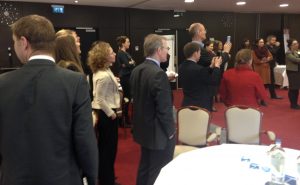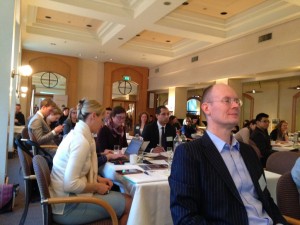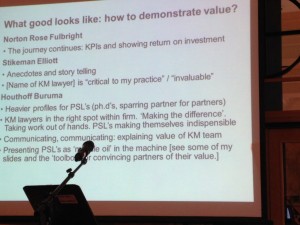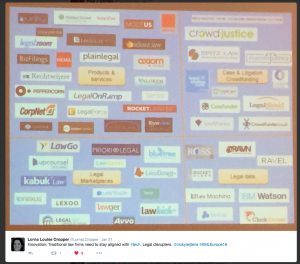 January in Amsterdam has become a bit of a tradition as is leading the opening session at KM Legal Europe.
January in Amsterdam has become a bit of a tradition as is leading the opening session at KM Legal Europe.
My brief was to replicate 2016 and provide a stimulating opening. I was delighted with the enthusiastic response and the level of interaction that occured over the two days expertly led again by Chair Raffael Büchi.
So what did I see and hear (and learn), and where is Legal KM one year on?
What trends did I see?
The ‘big’ trends for me were:
- A headlong rush into document automation. “Automating the drafting of legal documents” = intelligent workflow with knowledge embedded that reduces duplication and saves time. 50% of the room said their organisation was engaged in some form of document automation. And its easy to see why its appealing. One statistic that was shared: a saving of 200 lawyer hours a month from 1,150 templates automated. Interestingly this presents a great opportunity for KM’ers with Document Automation installaton experience. Not enough experience vs. too many installations. Importantly another value of Doc Auto: Training young lawers – gets them up to speed quicker as questions it poses makes them understand.
- The ongoing challenge of getting adoption for the plethora of KM related initiatives: As one speaker suggested, the key is getting them set up yourself f2f. Don’t subcontract to IT. And ‘Celebrate’ use. Communication needs a good narrative to motivate people and get engagment. F2F meetings vital. Brand it as your product; Use advocates (Butterfly effect); Get testimonials.
- How often reporting lines change for KM’ers as their sponsor moves on. Few I spoke to were on the Managing Committee, many had seen their sponsorship downgraded.
What surprised me?
-

The ease with which all the delegates (many in suits) enthusiastically engaged with the opening exercise I ran and were suprisingly open and candid about “what do you bring to the event?” and “what are the big issues you are facing and would like an answer to?”
- That despite the promotional hype, machine learning engines still require a lot of manual input upfront from people with domain knowledge to get started which is why there is a growth in companies offering to do the setup work. Need to have engaged partner to drive document automation yet some lawyers enjoy drafting docs – issue: WIIFM (What’s in it for me?) is not addressed.
- That some firms really get the value of KM. European Law Firm of Year; Swiss Law Firm of Year, UK Law Firm of Year. A Common thread? All have KM Heads who are attending the event. The European Law Firm of the Year had a Senior Partner, the Partner responsible for KM and the KM Head. They are one of few firms to have adopted ISO 9001 Quality Management -realised needed something to unify disparate offices and integrate aquisitions. The dna of the firm: based around the Practice Management System their default system (CRM plus) containing a body of knowledge on the Baltic region which can be put to multiple uses for the firm. It also serves as a timesheet for billable time. Challenge is how to replace so they embarked on a firm wide stakeholder engagement to produce a requirements specification. Note it was not seen as an IT Project!
- The way in which the dynamic / energy changes at an event when it reverts to “Show and Tell” vs “Ask and Share” The lesson those engaged in the creating and running of events like this took away was that you need people energised from the ‘get go’ each day.
- That many thought you could engage in Knowledge Capture via forms and macros. As I tweeted: My great fear – you don’t get critical knowledge captured by completing a form – you need to do it around events and in person!
- That Data Breaches have become a way of life – firms need process for dealing with them as penalties are punitive.
Quotes that stuck (or got tweeted)
Machine learning needs external input to get it going, its a classic case of GIGO – Garbage in Garbage out!
AI: not magic, evolved from sophisticated search. Previously Autonomy inspired plus document automation and NLP thx
@JoannaMG22AI: when it works its looking at human processes and how to support /emulate with computers to help them make better decisions.
Choosing the right system for your firm is not an IT project, it is a deeply strategic decision – Aku
@SORAINEN_LatviaOne revealing survey result from Lawyers: “How can I ask without looking silly?” – loss of face is a real barrier to adoptiion!
Adoption Tips for Sceptics: Articulate savings; Flatter Rocket Scientists and invite contributions; Ignore unbelievers who often turn when others are doing it and they feel peer pressure to join them.
Knowhow management is not a “ding an sich”, separated from other business functns. It’s just a regular part of good management.
What advice would I give Legal KM’ers?
- Your role will involve more Curation and Facilitiation (2 of the 8 ‘ates I talk about elsewhere in describing the future role of the ‘Knowledgeur’) as the need to consolidate corporate knowledge becomes increasingly digital. Tools should be based on the strategic direction of the firm; learning (not training) sessions ensure people are versed in their use. But don’t forget one of the most important KM tools is Coffee – one new KM leader had 420 coffees in first couple of months!
- Don’t be afraid to use external speakers to stimulate an in house response and introduce an element of competition. Round table cafes are successful in Switzerland – over food!
- Embrace technology as it’s here to stay. Where possible use the systems already in house. Develop practice groups to help produce requirements specifications. And make sure you are clear the role each tool is playing.
- You can achieve a lot with a little. Real change is often simple and inexpensive. In one example the PA’s wanted a practice group to organise calendars and email traffic and Intranet needed quick links. Both were low level but effective and resulted in improved productivity. Where possible use the systems already in house.
- Be opportunistic: A Good KM /comms /engagement. The Brexit vote gave impetus to a “Hot Topic” project in one firm. By consolidating all that was known and equipping lawyers with answers the profile of the team rose. Learning: people like getting together to discuss topics.
- KM Legal needs to be closely aligned with Learning & Development and HR. One firm developed a 1 week corporate program (mini MBA) that included KM focused on competency gaps. Their KM Committee reports straight to Managing Partner. It has teeth and includes core functions of the business.
- Develop a suite of simple facilitation tools and techniques: One firms uses POSE acronym to drive all meetings: Purpose / Owner / Safety / Engagement. I’ve often used DEBRIEFS.
- Become part of the business development process: Many firms now see KM involvement as important to winning new business or as part of the broader service offering.
And finally:
AI: when it works its looking at human processes and how to support / emulate with computers to help them make better decisions
I see this as being an evolution rather than a revolution. We are at Stage 3.
Stage 1 Search: Making documents, images and audio/video available and tagged;
Stage 2 Review & Connect: Analyse/summarise documents, images & audio/video push to relevant people. Identify patterns, connect; and
Stage 3 Predict & Facilitate: Using raft of data, information & accumulated knowledge to predict likely outcome & facilitate
One of the real highlights was that 20 people joined me for an impromptu conference dinner at a nearby Pho Vietnamese Restaurant. It reinforced the importance of food and drink in being lubricants for great conversations.
I took away a feeling that this question is still not being addressed satisfactorily and that firms remain at risk when people and teams leave or are acquired:
The risk of critical knowledge loss is not just about what people know, its about who they know and what networks they might know.
Perhaps AI will help in consolidating the know how of firms and hence build resilience into their models which remain vulnerable if people (and teams leave). Certainly the approach being adopted by the European Law Firm of the year of integrating CRM and workflow with precedents and transaction management is a bold step. Only time will tell if its successful and becomes the blueprint.



 A year on from the
A year on from the 

